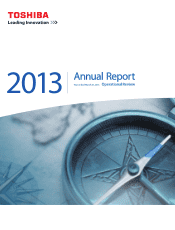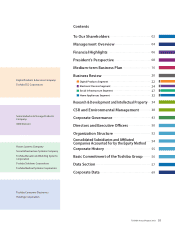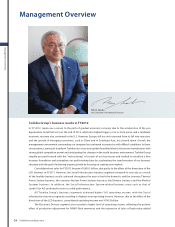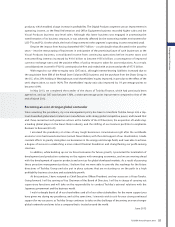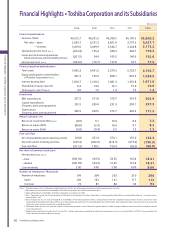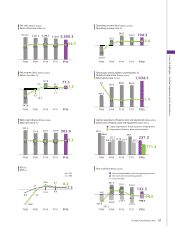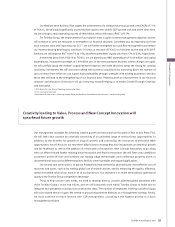Toshiba 2013 Annual Report Download - page 7
Download and view the complete annual report
Please find page 7 of the 2013 Toshiba annual report below. You can navigate through the pages in the report by either clicking on the pages listed below, or by using the keyword search tool below to find specific information within the annual report.
products, which enabled a large increase in pro tability. The Digital Products segment saw an improvement in
operating income, as the Retail Information and Office Equipment business recorded higher sales and the
Visual Products business saw level sales. Although this latter business was engaged in promoting the
transformation of its business structure, it was adversely a ected by the worsening market environment for
LCD-TVs and PCs. On the whole, the level of improvement in the segment’s operating income remained small.
Despite the impact from having channeled ¥59.7 billion – a scale double that allocated in the past few
years – into the restructuring of businesses in anticipation of the promising future of such businesses as the
Visual Products business, consolidated income from continuing operations before income taxes and
noncontrolling interests increased by ¥10.0 billion to become ¥155.6 billion, a consequence of improved
currency exchange rates and the positive effect of policy measures taken for asset reductions. As a result,
consolidated net income for FY2012 continued to be rm and ended with an increased pro t of ¥77.5 billion.
With regard to our debt-to-equity ratio (D/E ratio), although interest-bearing liabilities increased due to
the acquisition from IBM of the Retail Store Solution (RSS) business and the purchase from the Shaw Group in
the U.S. of its 20% holding in Westinghouse, total shareholders’ equity improved, in part due to the e ect of the
yen’s depreciation, to reach 142%. The shareholders’ equity ratio also improved by 1.9 percentage points to
become 16.9%.
In May 2013, we completed the transfer of the shares of Toshiba Finance, which had previously been
agreed on, and our D/E ratio became 136%, a seven-percentage-point improvement compared to that of the
end of March 2012.
Becoming an even stronger global contender
Since assuming the presidency, my core management policy has been to transform Toshiba Group into a top-
level diversi ed global electric/electronic manufacturer with strong global competitive power, and toward that
end I have carried out such proactive actions as the transfer of the LCD business, the acquisition of Landis+Gyr,
a leading global player in the Smart-Meter industry, and the shifting of our business portfolio to emphasize
Business to Business (B to B).
I assumed the presidency at a time of very tough businesses circumstances right after the worldwide
economic crisis had caused enormous turmoil. Nevertheless, with the solid support of our shareholders, I made
constant e orts to greatly strengthen our businesses in the energy and storage elds, and I was able to achieve
a degree of success in establishing a more robust nancial foundation and strengthening our pro t-making
structure.
In addition, while building up our six focus businesses for future growth, I promoted the localization of
development and production centering on the regions with emerging economies, and we are moving ahead
with the development of superior products and services for global developed markets. As a result of pursuing
these proactive management policies, I believe that we were able to provide the roadmap for the future
directions of Toshiba Group and also put in place systems that are re-starting us on the path to a high
pro tability business structure and sustainable growth.
At this juncture, I have resigned as Chief Executive O cer/President, and my successor is Hisao Tanaka.
Going forward, I will be serving as Vice Chairman of the Board of Directors, I will be in charge of carrying out
supervisory functions and will take on the responsibility to conduct Toshiba’s external relations with the
Japanese government and the business world.
I wish to deeply thank all of our shareholders and all of our other stakeholders for the warm support you
have given me during my presidency, and at the same time, I sincerely wish to ask for your strong continued
support for my successor, as Toshiba Group continues to take on the challenge of becoming an even stronger
global contender and aims to be a company that is trusted around the world.
June 2013
Management Overview
05
TOSHIBA Annual Report 2013

